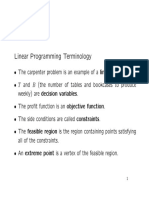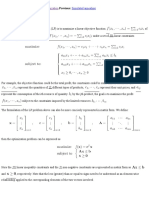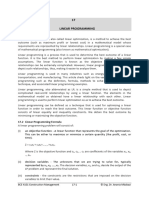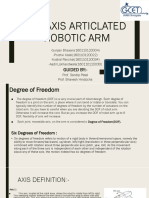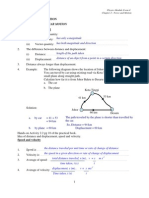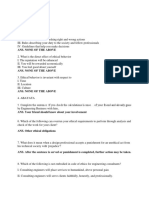Key Notes: Chapter-12 Linear Programming
Uploaded by
Aditya YadavKey Notes: Chapter-12 Linear Programming
Uploaded by
Aditya YadavKey Notes
Chapter-12
Linear Programming
• A linear programming problem is one that is concerned with finding the optimal value
(maximum or minimum) of a linear function of several variables (called objective function)
subject to the conditions that the variables are non-negative and satisfy a set of linear
inequalities (called linear constraints). Variables are sometimes called decision variables
and are non-negative.
• A few important linear programming problems are:
(i) Diet problems
(ii) Manufacturing problems
(iii) Transportation problems
• The common region determined by all the constraints including the non-negative constraints
x ≥ 0, y ≥ 0 of a linear programming problem is called the feasible region (or solution
region) for the problem.
• Points within and on the boundary of the feasible region represent feasible solutions of the
constraints. Any point outside the feasible region is an infeasible solution.
• Any point in the feasible region that gives the optimal value (maximum or minimum) of the
objective function is called an optimal solution.
• The following Theorems are fundamental in solving linear programming problems:
Theorem 1 Let R be the feasible region (convex polygon) for a linear programming problem
and let Z = ax + by be the objective function. When Z has an optimal value (maximum or
minimum), where the variables x and y are subject to constraints described by linear
inequalities, this optimal value must occur at a corner point (vertex) of the feasible region.
Theorem 2 Let R be the feasible region for a linear programming problem, and let be the
objective function. If R is bounded, then the objective function Z has both a maximum and a
minimum value on R and each of these occurs at a corner point (vertex) of R.
Material Downloaded From SUPERCOP
Key Notes
• If the feasible region is unbounded, then a maximum or a minimum may not exist. However, if
it exists, it must occur at a corner point of R.
• Corner point method for solving a linear programming problem. The method comprises of
the following steps:
(i) Find the feasible region of the linear programming problem and determine its corner
points (vertices).
(ii) Evaluate the objective function Z = ax + by at each corner point. Let M and m
respectively be the largest and smallest values at these points.
(iii) If the feasible region is bounded, M and m respectively are the maximum and
minimum values of the objective function.
If the feasible region is unbounded, then,
(i) M is the maximum value of the objective function, if the open half plane determined by
ax + by > M has no point in common with the feasible region. Otherwise, the
objective function has no maximum value.
(ii) m is the minimum value of the objective function, if the open half plane determined by
ax + by < m has no point in common with the feasible region. Otherwise, the
objective function has no minimum value.
• If two corner points of the feasible region are both optimal solutions of the same type, i.e.,
both produce the same maximum or minimum, then any point on the line segment joining
these two points is also an optimal solution of the same type.
Material Downloaded From SUPERCOP
You might also like
- 12_maths_key_notes_ch_12_linear_programmingNo ratings yet12_maths_key_notes_ch_12_linear_programming2 pages
- Maths Xii Chapter 12 Linear ProgrammingNo ratings yetMaths Xii Chapter 12 Linear Programming39 pages
- Iit-Aieee-Books - Blogspot.in: Class XII: Math Chapter 12: Linear Programming Chapter NotesNo ratings yetIit-Aieee-Books - Blogspot.in: Class XII: Math Chapter 12: Linear Programming Chapter Notes6 pages
- Chapter 12 - Linear Programming Revision NotesNo ratings yetChapter 12 - Linear Programming Revision Notes8 pages
- Class 12 Maths Notes Chapter - 12. Linear ProgrammingNo ratings yetClass 12 Maths Notes Chapter - 12. Linear Programming49 pages
- Class 12 Chapter 12 Maths Important FormulasNo ratings yetClass 12 Chapter 12 Maths Important Formulas2 pages
- Linear Programming: Key Concept InvolvedNo ratings yetLinear Programming: Key Concept Involved2 pages
- Graphical Method: Module - 1 Lecture Notes - 3 Linear Programming Problems-INo ratings yetGraphical Method: Module - 1 Lecture Notes - 3 Linear Programming Problems-I5 pages
- The Indian Public School, Erode: Senior Secondary - Grade Xii LPP (Study Material)No ratings yetThe Indian Public School, Erode: Senior Secondary - Grade Xii LPP (Study Material)2 pages
- Linear Programming Class 12 Notes CBSE Maths Chapter 12No ratings yetLinear Programming Class 12 Notes CBSE Maths Chapter 1210 pages
- LINEAR PROGRAMMING DEFINITIONS (MATHEMATICS)No ratings yetLINEAR PROGRAMMING DEFINITIONS (MATHEMATICS)1 page
- Linear Programming: I Simulated AnnealingNo ratings yetLinear Programming: I Simulated Annealing5 pages
- Chapter 1: Introduction To Operations Research: The Modelling ProcessNo ratings yetChapter 1: Introduction To Operations Research: The Modelling Process19 pages
- Module 7 B Solving Linear Inequalities Using Linear ProgrammingNo ratings yetModule 7 B Solving Linear Inequalities Using Linear Programming11 pages
- Learner'S Module: Mathematics in The Modern WorldNo ratings yetLearner'S Module: Mathematics in The Modern World5 pages
- Chapter 6 - Optimization and Its Applications in Chemical EngineeringNo ratings yetChapter 6 - Optimization and Its Applications in Chemical Engineering61 pages
- Linear Programming I: Formulation and Graphic Solution: X X X Objective Function X X X X X XNo ratings yetLinear Programming I: Formulation and Graphic Solution: X X X Objective Function X X X X X X3 pages
- Linear Programming - The Graphical MethodNo ratings yetLinear Programming - The Graphical Method6 pages
- Lesson 03 Graphical Method For Solving L PPNo ratings yetLesson 03 Graphical Method For Solving L PP19 pages
- BCE 4104 Construction Management Notes - Part 2No ratings yetBCE 4104 Construction Management Notes - Part 258 pages
- Exercise 1: Pricing Options With The Binomial ModelNo ratings yetExercise 1: Pricing Options With The Binomial Model4 pages
- Lecture-1 Inventory Control IntroductionNo ratings yetLecture-1 Inventory Control Introduction44 pages
- Six Axis Articlated Robotic Arm 2nd PresentationNo ratings yetSix Axis Articlated Robotic Arm 2nd Presentation17 pages
- Thermal Dehydrocondensation of Benzene To Diphenyl in A Nonisothermal Flow ReactorNo ratings yetThermal Dehydrocondensation of Benzene To Diphenyl in A Nonisothermal Flow Reactor6 pages
- Chapter 2 Force and Motion TEACHER's GUIDE92% (12)Chapter 2 Force and Motion TEACHER's GUIDE44 pages
- Lecture 2 Physics and Physical MeasurementNo ratings yetLecture 2 Physics and Physical Measurement22 pages
- Twist, Writhe, and Geometry A Loop Containing Equally Spaced Coplanar BendsNo ratings yetTwist, Writhe, and Geometry A Loop Containing Equally Spaced Coplanar Bends16 pages
- Development of Mill Drives For The Cement IndustryNo ratings yetDevelopment of Mill Drives For The Cement Industry16 pages
- Technical Specification For Ventilator - InfantNo ratings yetTechnical Specification For Ventilator - Infant2 pages
- Direct Compression - An Overview: - ReviewNo ratings yetDirect Compression - An Overview: - Review4 pages
- Abc de Coordinacion de Corriente 1-10 PDFNo ratings yetAbc de Coordinacion de Corriente 1-10 PDF10 pages
- Cutter Option: Installation InstructionsNo ratings yetCutter Option: Installation Instructions14 pages






















